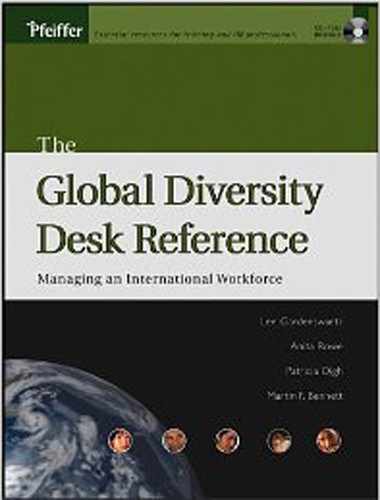1.9. THREE CULTURES MODEL
Cultural difference is complex. To simplify the process of identifying cultural difference in the workplace, we have created the Three Cultures Model from our work with global diversity professionals. This model posits three key cultural influences that are at work in global corporations: personal culture, national culture, and the organizational culture itself (shown in the figure). Being in an organization with a strong corporate culture does not negate the fact that individuals come to the table with their own personal characteristics and national tendencies, neither of which are sublimated to the organization's culture.
Professor André Laurent makes the following observation based on his study of multinational organizations: "Multinational companies do not and cannot submerge the individuality of different cultures. That is, strong as a corporate culture may be, the template for behaviors isn't from the company—but from the national culture."[] Recognizing the dramatic influence of national culture is key to operating globally.
Personal culture is the integration of an individual's traits, skills, and personality formed within the context of one's ethnic, racial, familial, and educational environments.
National culture is a shared understanding that comes from the integration of beliefs, values, attitudes, and behaviors that have formed the heritage of a nation-state.

Corporate culture represents the integration of widely shared institutional beliefs, values, and a guiding philosophy of an organization frequently espoused in its vision, mission, and values statements.
Adler asked fundamental questions about the interplay between these three cultures as early as 1986: Do organizational culture and structure determine people's behavior in organizations or does national or ethnical cultural conditioning limit the organization's influence? Does the culture that enters the organization through employees limit the influence of management-created organizational culture and structure? Apparently yes. Researchers such as André Laurent, Geert Hofstede, and Fons Trompenaars have found that national culture determines more about work-related values and behavior than position, role, age, gender, or race.
Some organizations try to downplay the possible impact of cultural difference between national, personal, and corporate cultures through careful employee selection. For example, Lotus Development Corporation appointed a team of local executives in their Japanese subsidiary with idiocentric cultural values (that is, individualists within a collectivist culture) to match the home culture more closely.[] In doing so, they often lost the very advantage that difference could bring the organization.
The Three Cultures Model is useful in analyzing culture clash situations. While there is no ideal "balance" among the three cultures in any organizational situation, using the model to analyze which cultural dimensions are at work in a given situation provides a starting point for dialogue and reconciliation. Filling out the "Three Cultures Model at Work" sheet may be helpful for an organization.
1.9.1. Suggestions for Using "Three Cultures Model at Work"
To help assess causes of cultural clashes in the organization
To deemotionalize cultural clashes and see them as issues to be analyzed and resolved
To challenge participants to build their own diagnostic tool for use in diagnosing cultural clashes
Intended Audience
Members of a global multinational work team, task force, or department
Managers of international or multicultural teams
Participants in diversity training programs
Time
45 to 60 minutes
Three Cultures Model at Work
|
Materials
Copies of "Three Cultures Model at Work"
Enlargements of "Three Cultures Model at Work" (optional)
Directions
Discuss the Three Cultures Model.
Ask participants to think of a clash that has occurred in the organization and ask them to respond to the questionnaire, following directions.
Have small groups members share their thinking and create jointly a set of diagnostic questions for each culture.
Questions for Discussion/Consideration
What challenges did you face in completing this worksheet?
How could you best gather the information you have indicated as necessary in the questions you created?
What are the benefits of gathering the type of information you have requested in your questions?
How can you employ this tool in your work group?
Cultural Considerations
The kind of abstract thinking required is not central to some cultures. Help those participants having difficulty with additional examples of questions that might be helpful.
Caveats, Considerations, and Variations
Sometimes participants will have difficulty identifying a situation on which to base their responses. Have several such examples ready for the group to use if this situation occurs.
